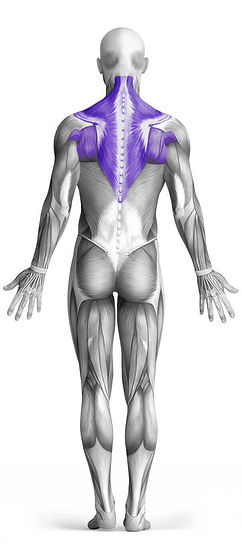Reverse Grip Incline Bench Two-Arm Dumbbell Row 101 Video Tutorial
0

Exercise Synopsis
Target Muscle Group
Upper Back
Execution
Compound
Force Type
Pull
Required Equipment
Dumbbell
Fitness Level
Intermediate
Variations
Timer
Hour
Minute
Second
Stopwatch
00:00:00:00
Overview
The Reverse Grip Incline Bench Two-Arm Dumbbell Row is a strength exercise that primarily targets the upper back, while also engaging the biceps, lats, and shoulders as secondary muscle groups. Performed on an incline bench, this movement allows for greater isolation of the upper back muscles by minimizing momentum. Using a reverse grip (palms facing forward), the lifter pulls the dumbbells towards their torso while keeping the elbows close to the body, emphasizing biceps activation along with back engagement. This exercise requires dumbbells and is effective for improving posture, building upper body strength, and enhancing muscle definition in the back and arms.
How to Perform
Position the Dumbbells
Place a pair of dumbbells at the upper end of an incline bench, ensuring they are within easy reach.
Set Your Body on the Bench
Lie face down on the bench with your chest positioned near the edge. Your feet can remain on the floor for stability or extend off the bench, depending on your preference.
Grip the Dumbbells with a Reverse Grip
Grasp the dumbbells with a reverse grip (palms facing forward). Lift them slightly off the ground while keeping your arms extended and maintaining control.
Maintain Proper Alignment
Keep your neck neutral, with your gaze directed forward to avoid unnecessary strain. Engage your core and upper back to stabilize your body.
Initiate the Rowing Motion
Exhale as you pull the dumbbells toward your torso, keeping your elbows close to your body. Focus on contracting your upper back muscles rather than relying on arm strength.
Squeeze at the Top
At the peak of the movement, squeeze your shoulder blades together to fully activate the upper back muscles. Hold this contraction for a brief pause to maximize engagement.
Lower with Control
Inhale as you slowly lower the dumbbells back to the starting position, maintaining control throughout the movement. Avoid letting the weights drop or using momentum.
Repeat for Desired Repetitions
Perform the exercise for the recommended number of reps, ensuring each movement is smooth, controlled, and effective in targeting the upper back, biceps, and shoulders.
★ Bonus: For exercises that involve external weights (such as dumbbells, barbells, or machines), the One Rep Max (1RM) calculator can help you estimate your maximum lifting capacity. Use it to track your strength progress and adjust your training for optimal results.
Tips
Maintain Elbow Position
Keep your elbows close to your torso throughout the movement to ensure proper engagement of the upper back and biceps. Avoid flaring them outward.
Keep Your Head Aligned
Maintain a neutral head position by looking slightly forward rather than tucking your chin or overextending your neck. This helps prevent strain and promotes better posture.
Control the Motion
Lift and lower the dumbbells in a slow, controlled manner, focusing on muscle engagement rather than momentum. Avoid jerking the weights up or letting them drop too quickly.
How Not to Perform
Avoid Flaring Your Elbows
Keep your elbows close to your torso throughout the movement. Letting them flare outward shifts the focus away from the upper back and increases strain on the shoulders, reducing effectiveness.
Do Not Use Momentum
Avoid swinging the dumbbells or jerking your body to lift the weight. Use slow, controlled movements to keep the tension on the upper back muscles and prevent unnecessary stress on the joints.
Don’t Lift Your Head Too High or Drop It Too Low
Keep your neck in a neutral position, looking slightly forward. Tilting your head too much in either direction can cause neck strain and take focus away from the targeted muscles.
Avoid Overarching or Rounding Your Back
Your spine should remain in a neutral position throughout the exercise. Overarching or hunching your back reduces engagement in the upper back muscles and increases the risk of injury.
Do Not Rush the Movement
Lowering and raising the dumbbells too quickly minimizes muscle activation and increases the likelihood of using improper form. Move slowly and deliberately to get the most out of each rep.
Avoid Letting the Dumbbells Drop
When lowering the dumbbells, control the descent rather than letting them fall. Dropping the weights too quickly reduces time under tension, making the exercise less effective.
Do Not Use Excessive Weight
Choosing a weight that is too heavy can compromise form and lead to using momentum instead of proper muscle engagement. Start with a moderate weight and increase as you build strength.
Do Not Hold Your Breath
Breathe rhythmically, exhaling as you pull the dumbbells up and inhaling as you lower them. Holding your breath can increase tension and reduce endurance.
Avoid Letting Your Shoulders Take Over
Focus on using your upper back muscles to drive the movement. If you feel the strain shifting to your shoulders or arms, reassess your form and engage your scapula for proper back activation.
Variations
Variations of fitness exercises refer to different ways of performing a specific exercise or movement to target various muscle groups, intensities, or goals. These variations aim to challenge the body differently, prevent plateaus, and cater to individuals with varying fitness levels.
Alternatives
Alternative exercises in fitness refer to different movements or activities that target similar muscle groups or serve the same training purpose as the primary exercise. These alternative exercises can be used as substitutes when the original exercise is unavailable or challenging to perform due to various reasons such as equipment limitations, injuries, or personal preferences.








